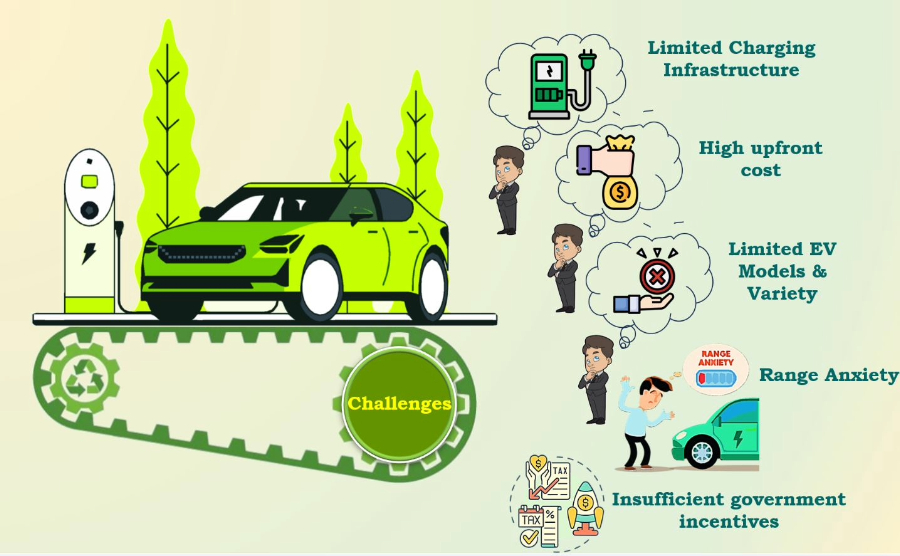Electric Vehicles in India
Commercially deploying electric vehicles (EVs) has expanded substantial momentum worldwide due to their well-known benefits. However, with rapidly growing urbanization in India, transitioning to electric mobility presents numerous challenges. Here, we explore the key obstacles hindering the widespread adoption of EVs in India and potential solutions to overcome these challenges.
Limited charging infrastructure
The scarcity of charging infrastructure is a significant hurdle for EV adoption in India. The Ministry of Road Transport & Highways reported that as of March ’23, the country has greater than 21 lakhs EVs on roads, for which we have only 5319 charging stations across 231 cities. These numbers are inadequate concerning availability, accessibility, and reliability. Accounting the Ministry’s projected compound annual growth rate (CAGR) of 94.4% by 2030 and assuming a linear growth pattern, for which let us calculate the number of EVs expected to be sold in India by 2030:
21 lakh EVs (as of now) × (1 + 0.944)(2030-2021) = Approximately 19.54 crore EVs by 2030
The above context is recommended with a ratio of one charging station for every 10 EVs. In terms of distance, assuming an average of 200 kilometers per charge, the total kilometers to be covered by these EVs would be approximately 3,908 crore kilometers. The charging stations should have different capacities, such as Level-2 DC fast-charging and ultra-fast charging, and they should adhere to standardized protocols and safety standards.
High upfront cost
The cost of popular electric car models in India, such as the Tata Nexon EV and MG ZS EV, ranges between INR 15-20 lakhs after subsidies. In contrast, equivalent gasoline variant vehicles are available at lower prices, making the initial purchase cost of EVs comparatively higher. In addition, the cost of lithium-ion batteries also forms a significant portion of EV costs, has been declining over the years. However, in 2022, the average cost of EV batteries was still around INR 12000- 16000 per kilowatt-hour (kWh), contributing to the overall high upfront cost.
Limited EV models and a variety
India has a limited variety of EV models available compared to conventional vehicles. As of June 2023, the number of EV models available in India was around 10-15, whereas there are hundreds of petrol and diesel model vehicles. This lack of variety hampers consumer choice and preferences, as potential buyers may not find an EV that suits their specific needs, such as different body types, sizes, or functionalities.
Range anxiety
Many electric cars in India range around 200-300 kilometers on a full charge. For instance, the Tata Nexon EV has an ARAI-certified range of 312 kilometers on a single charge. In a country with vast distances and limited charging infrastructure, the fear of running out of charge during long journeys or in remote areas can contribute to range anxiety among potential EV buyers.
Insufficient government incentives
The Indian government has executed various incentives and subsidies to promote electric vehicle adoption. For illustration, the Faster Adoption and Manufacturing of Electric Vehicles (FAME) scheme offers financial incentives for electric vehicle purchases. Under the 2019’s FAME-II schemes, the government allocated INR 10,000 crores to provide subsidies for electric two-wheelers, three-wheelers, and four-wheelers. These subsidies range from INR 10,000 to 150,000 depending on the vehicle type and battery capacity.
Solutions to combat the challenges
Expanding charging infrastructure and promoting decentralized charging solutions
The government and private sector should collaborate to expand the network of public charging stations nationwide rapidly. For instance, setting a target of 10,000 public charging stations by 2025 would significantly improve accessibility. Despite thinking conventionally on setting ambitious targets, making Public-private partnerships, etc., more focus should be given to intelligent charging stations, solar-integrated charging corridors, stationary solid oxide fuel cell based stations in H2 refilling stations, Battery Swapping Stations, and Vehicle-to-Everything (V2X) connectivity. Moreover, the focus should also be on encouraging the installation of 1 million home charging points and 100,000 workplace charging points by 2025 would enhance convenience and reduce range anxiety. For instance, if there are currently 50,000 home charging points, the target would be to add 950,000 more home charging points by 2025.
Strengthening public transportation
Promoting the adoption of electric buses and taxis within public transportation systems can be a significant driver for EV adoption in India. Implementing policies and providing financial incentives to fleet operators can encourage the transition to electric vehicles, thus reducing air pollution and improving urban mobility. Setting a target of 50,000 electric buses and 200,000 electric taxis by 2025 would contribute to the decarbonization of the transportation sector and increase public awareness and acceptance of electric mobility as a viable option for sustainable urban transportation.
Raising consumer awareness
Conduct awareness campaigns: Allocate resources for educational campaigns, test drive events, and demonstrations to increase consumer awareness about the benefits of EVs. For example, organizing 500 EV awareness campaigns across different cities would help dispel myths and promote adoption, just like how the EU and the US did for the early adoption of EVs in their respective nations.
Lowering upfront costs
Increase financial incentives: Enhance government subsidies and incentives for purchasing electric vehicles. For example, increasing the direct subsidy amount for EVs from the current INR 10,000 to 50,000 per vehicle would make them more affordable. If the government provides a subsidy of INR 40,000 for 1 lakh EVs, the total subsidy amount would be INR 40 crores.
Collaboration with the private sector
Establishing effective collaboration between the government and private sector stakeholders is crucial for successfully implementing electric vehicle adoption strategies. Public-private partnerships can leverage the expertise, resources, and market knowledge of automakers, charging infrastructure providers, and energy companies. By fostering joint initiatives, such as forming partnerships with select private companies for charging infrastructure deployment, the government can accelerate the development of a robust and interoperable charging network. Additionally, collaboration can facilitate aligning industry practices, policy frameworks, and technological advancements, enabling a seamless transition to electric mobility while promoting innovation and market competitiveness.
Source: https://bolt.earth/blog/future-electric-vehicles-india

